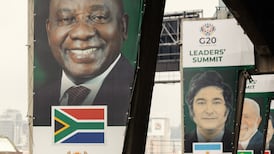For a 'demolition man', he was awfully well-dressed. It was a very institutional looking Matteo Renzi who this morning accepted a mandate, "with reserve", to form the 65th Italian government of the post-war era.
After spending more than an hour with state president Giorgio Napolitano, Democratic Party leader Mr Renzi appeared in front of the media at the Presidential Palace to confirm that, yes, he would try to form a new Italian government.
For the man who has talked a lot about radical change, not to say putting old-style, conspiratorial Italian politics “on the scrapheap”, his prime minister-in-waiting appearance this morning was distinctly understated and orthodox.
In his elegant dark suit, he looked for all the world like another of those “men with black suits and no faces” about whom Dolores Keane used to sing.
In his brief communication to the media, after which he took no questions, Mr Renzi did however try to convey the urgency and energy he hopes to bring to the task.
Essentially, he indicated that he hopes his government will tackle electoral and constitutional reform immediately this month, followed by significant measures relative to employment, to the public administration and to taxation in the following three months.
Even though he has arrived front stage in Italian politics with a reputation for getting things done quickly, Mr Renzi conceded that he might need some “necessary time” before he could finalise his government team, notwithstanding the urgency of the current moment.
To that end, he will formally open his round of consultations tomorrow just as soon as he has returned to his home town of Florence where this afternoon he will preside over his last City Council meeting in the role of mayor.
It is still possible, if by no means guaranteed, that Mr Renzi’s government could be sworn in and ready to face its first, all vital vote of confidence in the Senate by the end of the week.
Only then will he withdraw his “reserve”, becoming at the age of 39 the youngest prime minister of the post-war era. Ironically, only Il Duce, Bettino Mussolini, in modern times was as young as Mr Renzi since he too was 39 years old when he became prime minister in 1922.
As he sets about the formation of his government, Mr Renzi faces at least two immediate problems.
Firstly he must convince potential coalition partners, the New Centre Right (NCD), with regard to both the programme and the cabinet formation. NCD leader Angelino Alfano is believed to want at least four ministers in the new cabinet in order to counter-balance any swing to the left in the new executive.
Furthermore, ironically, he must convince the left of his own party, the Democratic Party (PD) that he has not entirely abandoned social democracy moving towards the centre.
A small minority of his own PD party are clearly very unhappy about the so-called PD “palace putsch” last Thursday which has catapulted Mr Renzi into office.










